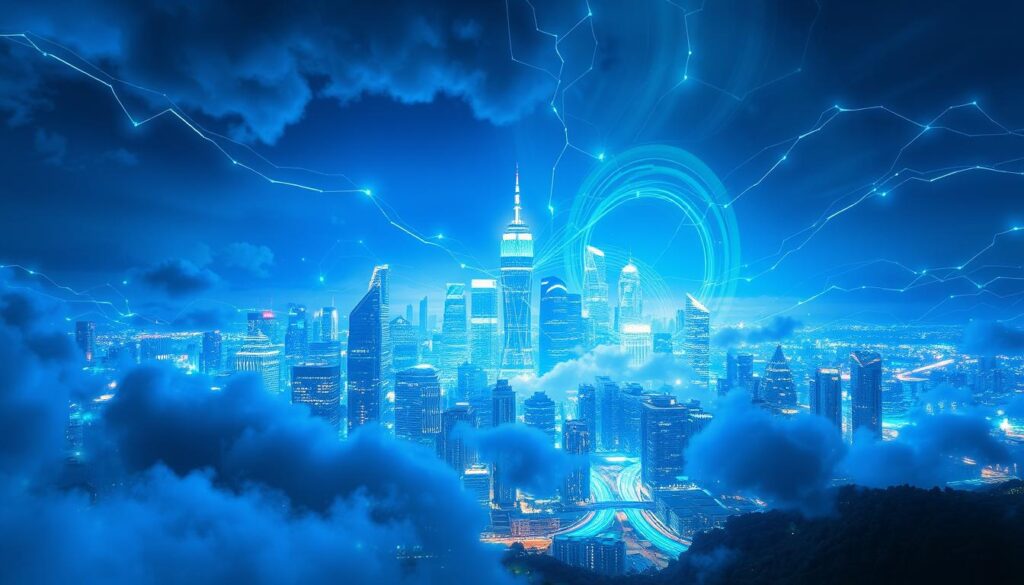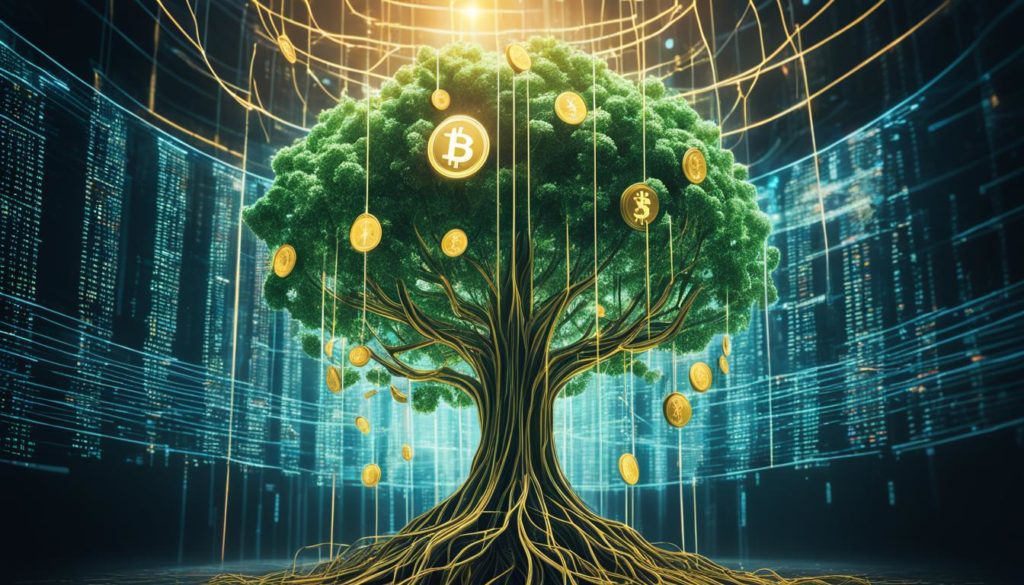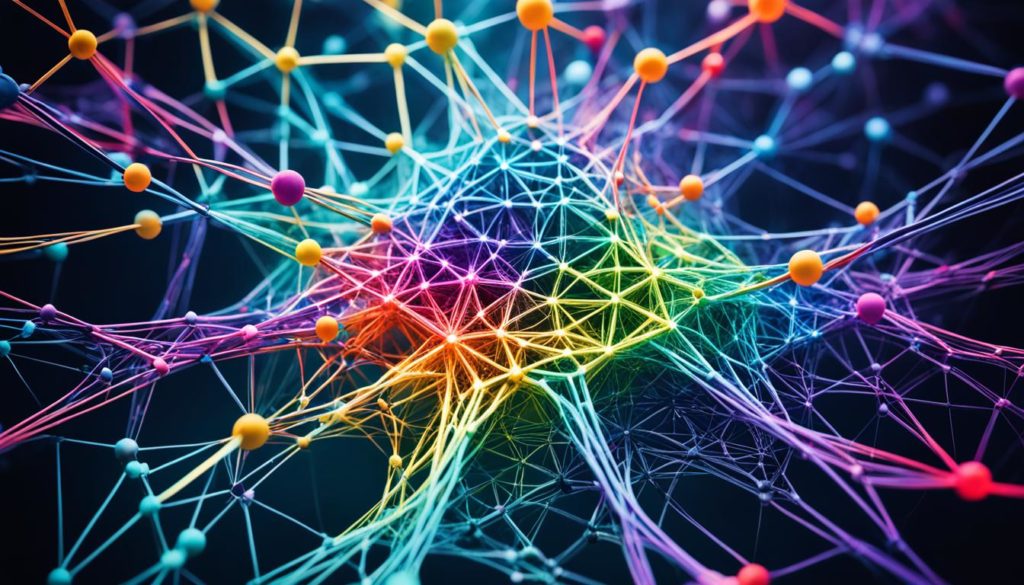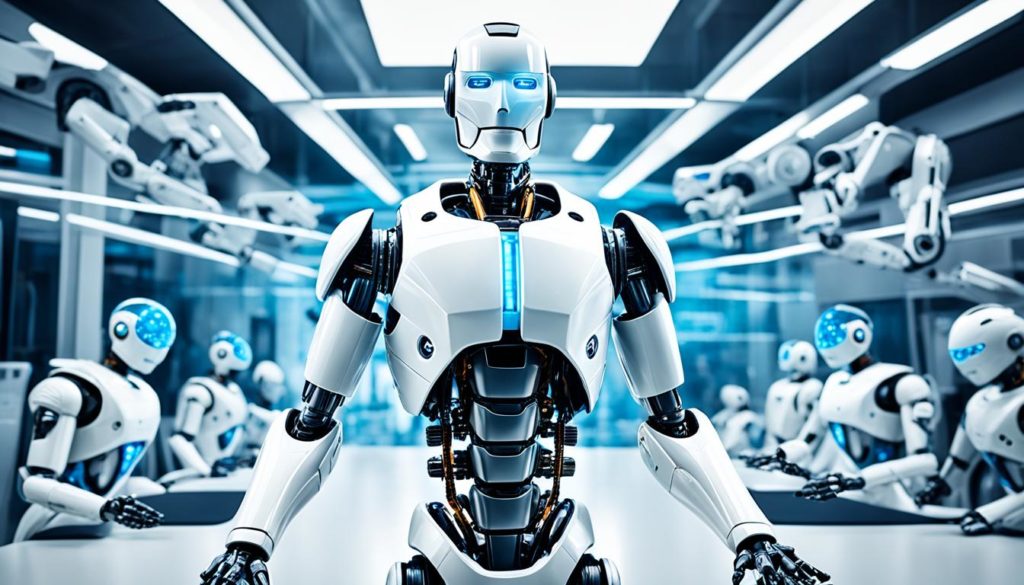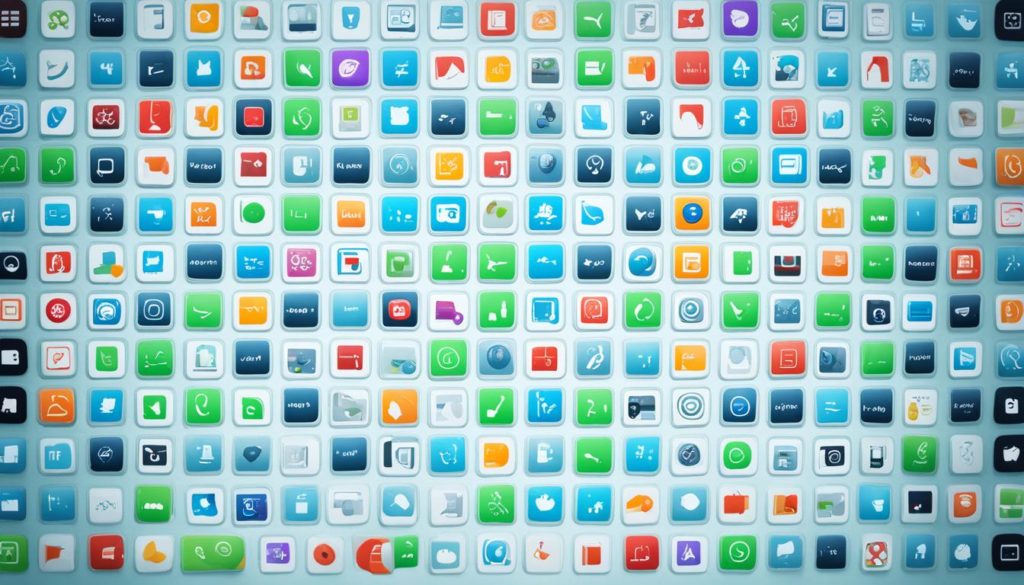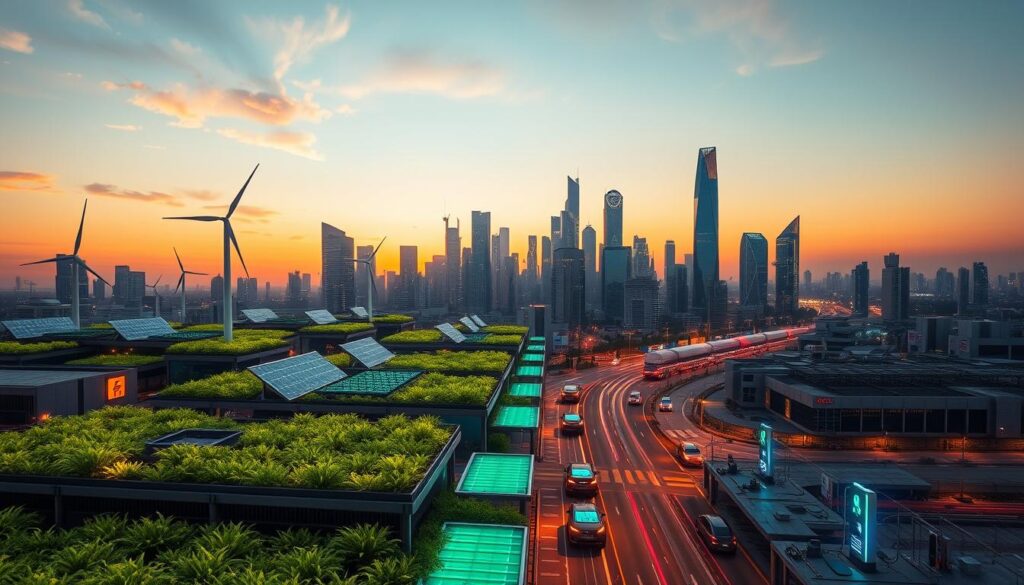
Did you know data centers might use up to 4% of global electricity by 2030? This is a big jump from today’s 1-2%. The demand for AI and machine learning is driving this increase.
As we explore generative AI, new technologies like Nvidia’s A100 and Intel’s Falcon Shores are using more power. The rise in AI accelerators and GPU shipments is making data centers focus more on energy efficiency.
Keeping data centers running is a big challenge. Goldman Sachs Research predicts a 160% increase in power demands by 2030. Companies like Nvidia, which holds 85% of the AI chip market, are pushing the energy use higher.
Efficiency is key. Nvidia’s Blackwell processors, for example, use less power to train models like OpenAI’s GPT-4. This progress is vital for meeting AI demands without harming the environment. Improving AI energy use is a big challenge, but new chip designs and advanced nodes like 3nm and 2nm offer hope.
Key Takeaways
- Data centers account for up to 2% of global power, a figure set to rise to 4% by 2030.
- AI accelerators like Nvidia’s A100 are causing a surge in power consumption.
- Goldman Sachs anticipates a 160% growth in data center electricity demand by 2030.
- Nvidia controls over 85% of the AI chip market.
- Nvidia’s Blackwell processors show promise with up to 25x energy efficiency improvements.
Investing in smart technologies and machine learning means we must manage power use carefully. As we explore these trends, finding a balance between tech progress and energy sustainability is crucial.
The Rising Demand for AI and Its Energy Implications
The growth of artificial intelligence has changed how we use energy, especially in data centers. With over a billion AI bot users worldwide, the need for AI is at an all-time high. This rise in demand has significant energy implications, affecting more than just system power.
The Impact of Generative AI
Generative AI is at the forefront of this technological advancement. Tools like ChatGPT are becoming more popular, leading to a big increase in energy use. A single chatbot query uses about ten times more energy than a Google search. This raises important questions about the sustainability of these advancements.
Increasing Power Consumption Per AI Chip
The power needs of AI chips are also a key concern. Chips from companies like Nvidia and AMD are using more power. For example, Nvidia’s A100 and H100 chips use a lot of watts. As AI tasks get more complex, the need for more power grows, even though chips are getting more efficient.
Surging Data Center Electricity Demand
The rise of AI requires bigger IT setups, leading to more energy use in data centers. Data centers use about 12% of the world’s energy for data processing. In places like Ireland, they use over 20% of all electricity. These centers need a lot of power, from 5-10 MW for small ones to over 100 MW for the biggest.
With data center construction investment doubling in the US in two years, we face a big challenge. We need to meet the growing demand for AI while making AI more energy-efficient.
AI Energy Consumption Projections
Understanding AI energy use is key, especially as AI hubs grow and get more powerful. AI energy consumption forecasts from trusted sources show big changes ahead. These forecasts point out challenges and areas for better energy use in AI.
Forecasts by Morgan Stanley and Wells Fargo
Morgan Stanley AI projections say global data center power use could triple soon, thanks to more AI work. This big jump means more AI use but also worries about energy needs. Wells Fargo energy statistics also show a huge increase in AI power demand by 2026. These numbers stress the need for energy-saving tech and green practices.
Data from the International Data Corporation (IDC)
The IDC data center energy trends give us more insight. IDC says AI data center energy use will grow by 44.7% each year, reaching 146.2 TWh by 2027. This growth fits with IDC’s bigger market study, showing data center electricity use could double by 2028 because of AI. The numbers show data centers face big costs as electricity demand goes up.
Looking at the stats from these groups helps us understand the future energy scene:
| Institution | Projection | Timeline |
|---|---|---|
| Morgan Stanley | Tripling of data center power usage | By next year |
| Wells Fargo | 550% surge in AI power demand | By 2026 |
| IDC | 44.7% compound annual growth rate, 146.2 TWh | By 2027 |
| IDC | Doubling of global data center electricity consumption | By 2028 |
These forecasts show the big change coming in AI and its energy needs. As we look ahead, it’s crucial to focus on using sustainable AI power consumption solutions.
Sustainable AI Power Consumption Solutions
Artificial intelligence (AI) is growing fast, but it uses a lot of energy. New ways to make AI use less power are being developed. For example, training a big AI model like GPT-3 uses as much electricity as 130 US homes in a year. We can make AI use less energy without losing its power.
Companies like Taiwan Semiconductor Manufacturing Company (TSMC) and NVIDIA are working on new tech. This tech uses less power and works better. Liquid cooling is also saving a lot of energy by cutting down on air conditioning in data centers.
Data centers are getting better at using energy. They’re using new designs and renewable energy. Watching an hour of Netflix uses about 0.8 kWh of electricity. But training big AI models uses a lot more. Making these changes is very important.
States like Georgia, Virginia, Washington, and Texas are improving their power systems for AI data centers. Despite the challenges, making AI use less power is key to a greener future. Big companies like Apple, Google, and Microsoft are leading the way by using more renewable energy. You can learn more about their efforts here.
Now, let’s look at some ways to make AI use less power:
- Improved Chip Efficiencies: New tech to use less power.
- Liquid Cooling Technologies: Better cooling to save energy.
- Redesigned Infrastructure: New data center designs for better energy use.
- Renewable Energy Adaptation: Using renewable energy for data centers.
Legislation is also helping. The Artificial Intelligence Environmental Impacts Act of 2024 in the US is a big step. It aims to reduce AI’s energy use. With AI’s energy use set to double by 2026, this is a timely move.
| Company | Action | Impact |
|---|---|---|
| TSMC | Advanced node technologies | Reduced power consumption |
| Microsoft | Chatbot server efficiency | 10 times less energy use |
| Renewable energy partnership | Lower carbon footprint | |
| NVIDIA | High-efficiency GPUs | Optimized AI energy usage |
Making AI use less energy is key to a greener future. From new tech to laws, we’re working together. Our goal is to reduce AI’s environmental impact.
Efforts to Reduce AI’s Carbon Footprint
The need to cut AI’s carbon footprint is urgent. Big tech companies are working on new ways to be green. They’re using renewable energy and making data centers more energy-efficient.
With over 50 gigatons of CO2 emissions each year, we must switch to sustainable practices fast.
Big Tech’s Sustainability Initiatives
Microsoft is leading the way in Big Tech’s green efforts. They aim to run their data centers on 100% clean energy by 2030. Oracle is also making big changes, adding power plants and liquid cooling to their data centers.
These moves help meet AI’s energy needs without harming the planet.
The Role of Renewable Energy in Data Centers
Renewable energy is key to reducing AI’s carbon footprint. Solar and wind power are cost-effective and green. They help meet the goal of net-zero emissions in the next 30 years.
Data centers, cryptocurrency, and AI will use 4% of global energy by 2026. Renewable energy data centers are crucial for sustainability. They show we can advance technology and protect the environment at the same time.
FAQ
What are the primary concerns regarding AI energy consumption?
AI technologies, especially generative AI, are growing fast. They use a lot of electricity. Data centers, which now use 1-2% of the world’s power, could use 3-4% by 2030. This growth worries us about carbon dioxide emissions and costs.
How is generative AI impacting energy consumption?
Generative AI needs a lot of computing power. This means data centers use more energy. For example, an AI query through ChatGPT uses almost ten times more electricity than a Google search. This shows how much power the latest AI models need.
Why is the power consumption of AI chips like Nvidia’s A100 and H100 increasing?
AI chips like Nvidia’s A100 and H100 are getting more powerful. This is because the industry wants to make better processors. These processors support big language models but use a lot of energy, as shown by the watts needed for the latest GPUs.
What are the projections for AI energy consumption?
Experts say AI energy use will grow a lot. Morgan Stanley thinks data center power use could triple soon. Wells Fargo expects AI power demand to surge by 550% by 2026. The IDC report says AI data center energy use will grow by 44.7% each year, aiming for 146.2 TWh by 2027.
How can we make AI more energy-efficient?
To make AI more energy-efficient, we need to use sustainable solutions. This includes better chip designs, liquid cooling, and advanced technologies. Companies like Taiwan Semiconductor Manufacturing Company (TSMC) are leading these efforts. They promise to use less power and perform better.
What steps are being taken to reduce AI’s carbon footprint?
Big Tech companies are investing in sustainability. They’re using solar and wind power. Companies like Oracle are building data centers with power plants and liquid cooling. These steps help data centers be green while staying up-to-date.
How does the adoption of renewable energy benefit data centers?
Using solar and wind power helps data centers grow without harming the environment. It ensures we can keep advancing technology while being green. This helps reduce AI’s carbon footprint.
Future App Studios is an award-winning software development & outsourcing company. Our team of experts is ready to craft the solution your company needs.


